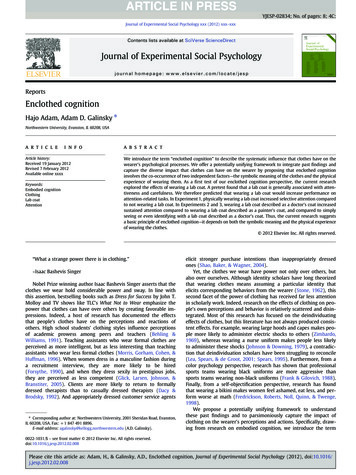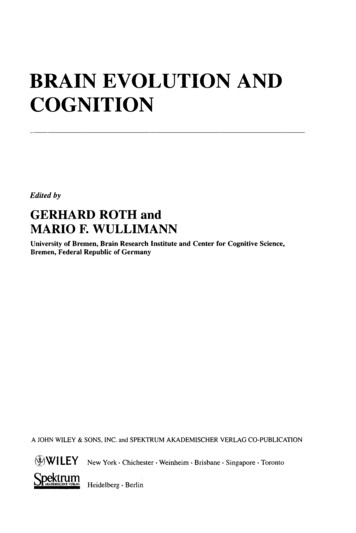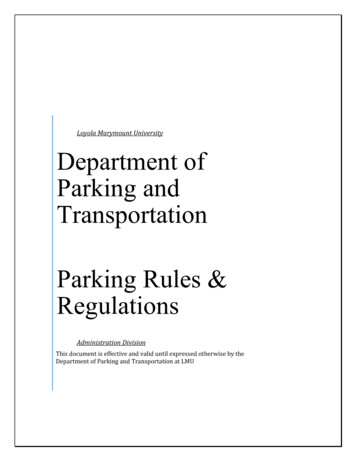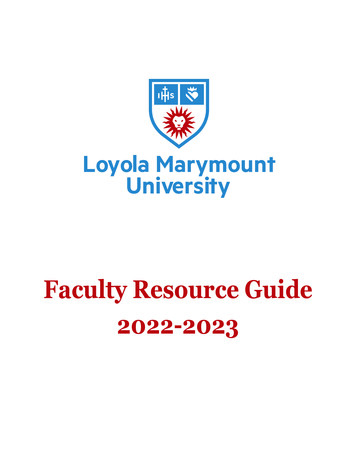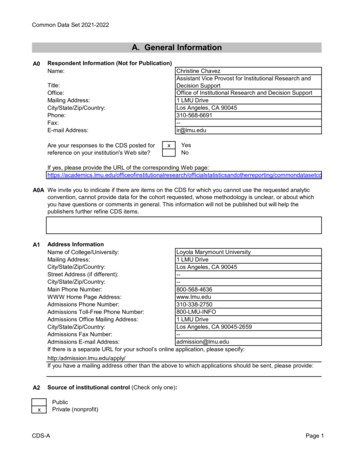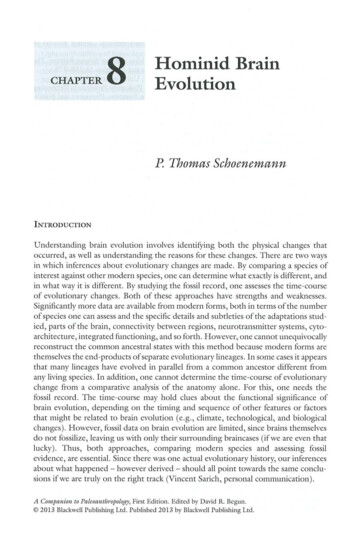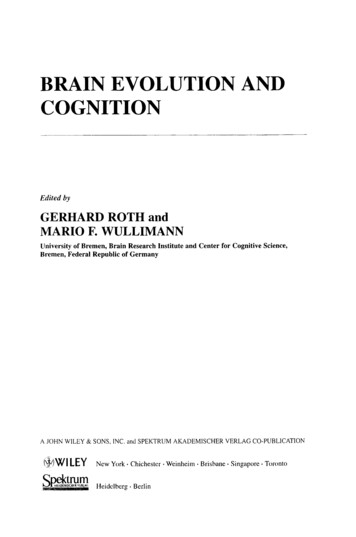
Transcription
BRAIN EVOLUTION ANDCOGNITIONEdited byGERHARD R O T H andMARIO F. WULLIMANNUniversity of Bremen, Brain Research Institute and Center for Cognitive Science,Bremen, Federal Republic of GermanyA JOHN WILEY & SONS, INC. and SPEKTRUM AKADEMISCHER V E R L A G CO-PUBLICATIONN e w York Chichester Weinheim Brisbane Singapore TorontoSpektrumfe Ii Im i iiiSiMi5 ii iSmiHeidelberg Berlin
Copyright 2001 by John Wiley & Sons, Inc. and Spektrum Akademischer VerlagJohn Wiley & Sons, Inc.605 Third AvenueNew York, NY 10158-0012USASpektrum Akdemischer VerlagVangerowstrasse 20D-69115 HeidelbergGermanyTelephone: (212) 850-6000Telephone: 49 6221 91260Address all inquiries to John Wiley & Sons, Inc.Published simultaneously in Canada.All rights reserved. No part of this publication may be reproduced, stored in a retrieval System ortransmitted in any form or by any means, electronic, mechanical, photocopying, recording, scanningor otherwise, except as permitted under Sections 107 or 108 of the 1976 United States Copyright Act.without either the prior written permission of the Publisher, or authorization through Payment of theappropriate per copy fee to the Copyright Clearance Center, 222 Rosewood Drive, Danvers, M A 01923,(508) 750-8400, fax (508) 750-4744. Requests to the Publisher for permission should be addressedto the Permissions Department. John Wiley & Sons, Inc., 605 Third Avenue, New York, NY 101580012, (212) 850-6011, fax (212) 850-6008, E-Mail: permreq@wiley.com.While the authors, editors and publishers believe that drug selection and dosage and the specification andusage of equipment and devices, as set forth in this book. are in accord with current recommendationsand practice at the time of publication, they accept no legal responsibility for any errors or omissions, andmake no warranty, expressed or implied, with respect to malerial contained herein. In view of ongoingresearch, equipment modifications. changes in governmental regulations and the constant flowof information relating to drug therapy, drug reactions, and the use of equipment and devices, the reader isurged to review and evaluate the information provided in the package insert or Instructions for each drug,piece of equipment, or device for, among other things, any changes in Instructions or indication of dosageor usage and for added warnings and precautions.Library of Congress Cataloging-in-Publication DataBrain evolution and Cognition / edited by Gerhard Roth and Mario F. Wullimann.p. cm.Includes index.ISBN 0-471-33170-8 (cloth : alk. Paper)1. Cognition. 2. Brain-Evolution.I. Roth, Gerhard, 1942 Aug. 15- II. Wullimann, Mario F.QP360.5. B734 2001573.8'6-DC2100-023095Die Deutsche Bibliothek - CIP-EinheitsaufnahmeBrain evolution and Cognition / ed. By Gerhard Roth and Mario F. Wullimann. - New York ; Chichester;Weinheim ; Brisbane ; Singapore ; Toronto: Wiley ; Heidelberg ; Berlin : Spektrum. Akad. Verl. 2001ISBN 0-471 -33170-8This book is printed on acid-free paper.Printed in the United States of America10 9 8 7 6 5 4 3 2 1BayerischeStaatsbibliothekMünchen
ContentsINTRODUCTIONProblems in the study of brain evolution and Cognition1Mario F Wullimann and Gerhard RothHandicaps in the search for an evolutionary history of vertebrate brainsSilent revolutions emergingThe amniote telencephalon as a case in pointA special position for humans?What is Cognition?References123567PART I D E V E L O P M E N T A L AND ADULT BRAINO R G A N I Z A T I O N IN E V O L U T I O N1Brain phenotypes and early regulatory genes:The Bauplan of the metazoan central nervous system11Mario F WullimannIntroduction11Comparative phenotypic analysis of metazoan central nervous characters. . . . 13The cladistic framework13A can of worms: Plathelminths, nemathelminths, nemertines14The molluscan controversy20The arthropod CNS, rather than being ancestral to the vertebrate CNS,is equally remote from the basic bilaterian Bauplan as the craniale brain. . 22Deuterostome nervous Systems25Conclusion28Early genes in neural development - Do they teil a different story?30Development and Bauplan of the vertebrate CNS30Early regulatory genes and neuromeres in the vertebrate brain32Early regulatory genes and the insect CNS32Phylogenetic Interpretation of molecular genetic and phenotypic data . . . . 34Conclusion36References372The echinoderm nervous System and its phylogenetic interpretation41Thomas Heinzeller and Ulrich WelschIntroductionDescription of Nervous SystemsLarval nervous SystemPostmetamorphotic nervous System: Common features41444445
vi3ContentsPostmetamorphotic nervous System: Group-specific featuresCryptosyringidaInter-class comparison of sensory versus motor functionQuestions of SymmetryCentral part of the bodyBilateral symmetry and segmentation of the armsAre echinoderm arms homologous with bilaterian trunks?Echinoderm ectoneural cord versus chordate neural plateAdditional body axesHydrocoel and notochord - are they convergent or homologous?Locomotion of EchinodermsPhylogenetic AspectsConsistency versus flexibility of regulatory genesGarstang's hypothesisSystematics of echinodermsMissing volution of vertebrate motor Systems77Hans J. ten DonkelaarIntroductionBasics of vertebrate locomotionPrehensile extremities4778084Features of the ancestral vertebrate motor System85Neural control of quadrupedal locomotionSupraspinal controlDescending supraspinal pathwaysThe cerebellorubrospinal limb control systemThe special case for birdsSummaryReferences91939398104106107Sensory system evolution in vertebrates113William Hodos and Ann B. ButlerHow many senses?How many cranial nerves?Trends in sensory system evolutionAscending sensory pathwaysNeuroembryology and the evolution of sensory SystemsEvolution of new sensory receptorsEvolution of new primary, secondary, and higher ordersensory nuclei113115116119120122122
Contents5viiThe evolution of sensory specialistsEvolution of central sensory pathwaysThe evolution of new central sensory nucleiThe evolution of sensory mapsLoss of sensory receptors and central pathwaysMechanisms of sensory system evolutionReferences123124125126127130131Evolution of the forebrain in tetrapods135Tom Shimizu6IntroductionEvolution of tetrapodsEarly tetrapods - Ancestral amphibiansEarly amniotes - Ancestral reptilesSynapsids - MammalsSauropsids - ReptilesSauropsids - BirdsConclusionForebrain Organization of living tetrapodsAmphibian patternMammalian patternSauropsid patternConclusionEvolutionary history of the tetrapod forebrainEarly tetrapodsEarly amniotesSynapsids and sauropsidsConclusionEnvironmental pressures on the tetrapod forebrainAnamniote pattern versus amniote patternSauropsid pattern versus mammalian ortical macrocircuits185Rudolf NieuwenhuysIntroductionMajor sensorimotor projectionsControl SystemsReticular, greater limbic and general modulatory inputs toneocortical circuitryThe ascending reticular systemThe greater limbic systemMonoaminergic and cholinergic modulatory Systems185186189192192193194
viii7ContentsCortico-subcortico-cortical association SystemsThe thalamic association systemThe striatal association systemThe cerebellar association systemSummaryReferences195196198199201202Hunting in barn owls: Peripheral and neurobiological specializationsand their general relevance in neural computation205Hermann WagnerIntroductionEvolutionary position and geographical distribution of the barn owlHunting as a complex behaviorGeneral commentsFormal description of the hunting SituationAdaptations of barn owls to hunting in the nightThe barn owl's brainMorphological adaptations of the owl's brain to hunting andlife at night8205206206206208209212213Physiological adaptationsCoincidence detectionFurther brain adaptations subserving sound-localization behaviorDifferences in the representation of acoustic space in diurnal andnocturnal owlsGeneral meaning of coincidence detection and 6218225228231232Evolution and devolution: The case of bolitoglossine Salamanders237228Gerhard Roth and David B. WakeIntroductionThe BolitoglossiniThe brain of Salamanders and frogs237238244The visual system of bolitoglossines249Retina and retinofugal systemTectumThe fate of other sensory SystemsCauses and consequences of simplification in the context ofpaedomorphosisWhat do bolitoglossines teil us about evolution in general and brainevolution in particular?References249250253254258260
Contents9Evolutionary constraints of large telencephalaix265Gerd Rehkämper, Heiko D. Frahm, and Michael D. MannEvolution -What does that mean?Brain and brain part size as a heuristic toolWhat factors influence brain size or brain part size?There is no brain size alterationBrain size alterations are epiphenomenaBrain size is influenced by individual learningBrain size and brain part size reflect adaptationDefinition of "large telencephala"MammalsTelencephala enlarged because of dominance of olfactory orientation . .Telencephala enlarged because of superior spatial CognitionTelencephala enlarged because of a voluminous isocortexIsocortex (and therefore, telencephalon) enlarged because ofelaborated somatosensory areas together with a necessity of motorcoordination in a subterranean lifeTelencephala enlarged because of multimodal IntegrationBirdsTelencephala enlarged because of olfactionTelencephala enlarged because of spatial CognitionTelencephala enlarged because of isocortical equivalentsDomesticated animalsAgain: Theories of brain size and brain compositionConclusionsReferencesPART I I265266268269269270271271272. 272272275276278278278279280283285288289C O G N I T I O N : F R O M N E U R A L BASIS T O B E H A V I O R10 Brain and cognitive function in teleost fishes297Leo S. Demski and Joel A. BeaverIntroductionStudies on Cognition in fishesBrain lesions and cognitive behavior in fishesTelencephalon: Nonspatial learningTelencephalon: Spatial learningCerebellumTectumRelative brain size and development: Implications for cognitivefunction in fishesStudies in minnows (Cypriniformes)Blind and sighted characins297298300300301302303304304306
xContentsThe cichlids of the African great lakesCoral reef percomorphsMicrocircuitry of telencephalic enhancements in selected percomorphs . . . .Area dorsalis telencephali pars lateralis (dorsal part)Area dorsalis telencephali pars centralisArea dorsalis telencephali pars medialisBehavioral studies on the enlarged telencephalon of percomorphsSummary and conclusionsReferences11 Cognition in insects: The honeybee as a study case306307311313317319321323325333Randolf Menzel, Martin Giurfa, Bertram Gerber, and Frank HellsternIntroduction: Brain, behavior, and biology of honeybeesBehavior and biology of honeybeesDesign of an insect brainElementary and configural forms of learning in classical conditioningThe preparation: Classical conditioning of the proboscisextension reflexA cognitive approach to memory dynamicsThe elementary-configural distinctionCognitive aspects of elementary forms of conditioning?Configural forms of conditioningLearning in the natural contextContext-dependent learning and retrievalSerial order in a spatiotemporal domainThe representation of space in navigationVisual discrimination learning in honeybees: Generalization,categorization, and concept formationConclusionBasic Cognition with a small brainThe ecological niche and basic CognitionReferences12 Insect 359360362367Nicholas J. StrausfeldIntroductionGeneral features of segmental gangliaThe protocerebrum and the preoral brainEvolutionary considerationsGeneral Organization of the protocerebrumThe mushroom bodiesStructureEvolution of mushroom bodies in insectsRelationship to primary sensory neuropils367368372372373375375377378
ContentsxiMushroom body physiologyRoles of mushroom bodiesThe central complexEvolutionary considerationsOrganization of the central complexCentral complex functionComparisons of brain regions amongst arthropodsMushroom bodiesThe central complexInsect and vertebrate brains comparedEquivalence of insect and vertebrate embryonic forebrainThe adult 339513 Conservation in the neurology and psychology of Cognitionin vertebrates401Euan M. MacphailIntroduction: Complexity in brains and behaviourSpecies differences in intelligenceBirds and mammals comparedThe basal gangliaPaleostriatal lesions and classical conditioning in the pigeonThe archistriatumPosteromedial archistriatum: Fear and avoidanceAnterior and intermediate archistriatum: Parallels with isocortexCortexOlfactory cortexHippocampal complexIsocortical analogues/homologuesConclusionsReferences14 Multimodal areas of the avian forebrain—Blueprintsfor 27431Onur Güntürkün and Daniel DurstewitzThethemeWorking memory and prefrontal cortexAvian brain and CognitionDetails of the machineThe decline of a memory störeSimulation of the machineLooking insideReferences431432434437439442449450
xiiContents15 Cognition of birds as products of evolved brains451Juan D. Delius, Martina Siemann, Jacky Emmerton and Li umerosityEpilogueReferences16 What can the cerebral cortex do better than other partsof the brain?451456461467472477483491Almut SchüzIntroductionBasic Connectivity of the isocortexThe cerebral cortex and CognitionComparative aspectsBrain size and ConnectivityAllocortex and reptilian cortexReferences17 Evolution and complexity of the human brain: Some organizingprinciples491492494497497498499501Michel A. HofmanIntroductionEvolution of brain sizeEncephalization in primatesGeneral constraints on brain evolutionEvolution and geometry of the cerebral cortexDesign principles of neuronal OrganizationBiological limits to information processingConcluding remarksReferences18 The evolution of neural and behavioral complexity501502505507510514515518519523Harry J. JerisonIntroductionVigilance and attention: An old-fashioned viewCosts and attentionCosts and brainsBrain size in living vertebrates: Allometry and encephalizationExceptionsEarly avian and mammalian encephalization523525526531533535539
ContentsProgressive encephalization in mammalsMore on neural informationNeural and behavioral complexityWhy some brains are big: What do big brains do?References19 The evolution of consciousnessxiii542544546547551555Gerhard RothPhenomenology of consciousnessThe neurobiological basis of the different states and appearancesof consciousnessCognition and consciousness in animalsAnimal brains and human brainConsciousness and 79580583
Chapter 1BRAIN PHENOTYPES AND EARLYREGULATORY GENES: THE BAUPLAN OFTHE METAZOAN CENTRAL NERVOUSSYSTEMMario E Wullimann, University of Bremen, Brain ResearchInstitute and Center for Cognitive ScienceINTRODUCTIONIn this chapter, I discuss certain aspects of the relationship between cladisticallyoriented comparative neuroanatomy and developmental neurogenetics. These twofields meet in the scientific search for the biological roots of the metazoan nervoussystem, one focusing on the phenotypic reconstruction of the basic Bauplan and itssubsequent evolutionary alterations, the other focusing on the fundamentaldevelopmental mechanisms creating that Bauplan and its variations. At first sight, onemight get the impression that the conclusions reached in these fields are contradictoryregarding the early evolution of the central nervous system (CNS). A closer look,however, reveals that this need not be the case. Ciadistic methodology is used withgreat success in comparative biology to reconstruct evolutionary patterns(e.g., ancestral phenotypes and their subsequent alterations). As is detailed later, recentconclusions regarding the ancestral phenotypic condition of the nervous system(e.g., with respect to its segmentation) are often based on patterns of gene expressionalone. The message purported here is simple: Ii may be fatal to ignore the results of anotherwise successful methodology of comparative biology (i.e., cladistics) in thespecial case of the nervous system because the genes appear to teil us a different story.Revolutionary studies in molecular genetics during the past decade showed thatvery many genes relevant for early neural development have orthologues in animalsas remotely related as fruit fly and mouse. The pax-6 gene is a prominent example(Callaerts et al., 1997). Orthologues of this gene are present in most metazoans wherethey are involved in eye morphogenesis at a hierarchically high level. By genetechnology means, pax-6 can experimentally be interchanged interspecifically andstill function within its host developmental program (Halder et al., 1995). This couldbe taken as proof that all phenotypes produced by the pax-6 gene are homologous.Thus, despite the fact that developmental programs with the pax-6 gene at the tophave been altered during metazoan evolution and led to similar eyes (Octopus eye
121Brain Phenotypes and Early Regulatory Genesand vertebrate eye) and dissimilar eyes (insect Compound eye and vertebrate cameraeye), the resulting phenotypes all become homologous according to the logic outlinedabove. Thus, usage of the term homology apparently is very critical. Wiley (1981)offered a useful definition that excludes convergence and parallelism: A character oftwo or more taxa is homologous ifthis character isfound in the common ancestor ofthese taxa, or, two characters (or a linear sequence of characters) are homologues ifone is directly (or sequentially) derived from the other(s). As far as their detailedsimilarity is concerned, the Octopus eye and the vertebrate eye represent neither case,but are in fact a case of parallelism. The novelty value of the pax-6 story is, however,that the underlying developmental program is partly identical in all metazoans andthat we can, thus, assume that the Octopus eye and the vertebrate eye are homologousto the eye of their last common ancestor.Even more relevant to the discussion raised here are those regulatory genes(e.g., the homeotic genes of the Hox complex) that are expressed in similar spatiotemporal patterns in various developing metazoan animals and control regionalization inthe anteroposterior axis, especially during head and CNS formation. Some of thesegenes involved in head and brain formation can also be functionally replaced amongmetazoan species (see later discussion). One might conclude that the ancestralcondition of the metazoan brain must have been rather complex already, for example,including a multisegmental structure (Reichert and Boyan, 1997). Such directinference from patterns of gene expression in recent species to an ancestral phenotypeis not, however, unchallenged by researchers who find alternative explanations for thesame facts (Akam, 1989; Slack et al., 1993). In the following, I attempt to reconcileinterpretations resulting from neurogenetics with those resulting from cladisticanalysis of the phenotype of the metazoan CNS.Cladistically oriented neuroanatomy using phenotypic characters reveals that there isindeed a pattern of ancestral (plesiomorphic) neural characters. Some of those may notchange during evolution and may be similar and homologous for that reason(non-neural example: many characters in the tetrapod foreleg). Other characters may,however, reach similarity independently (i.e., not inherited from a common ancestor),and they therefore represent homoplastic features as far as their similarity is concerned(e.g., bat and bird wings). Again, another class of characters may change (i.e., becomedivergent in their phenotype) but remain homologous (e.g., reptilian foreleg/bird wing).Note that if, hypothetically, all recent and extinct amniotes had wings, we would, basedon the very same data, conclude that bat and bird wings are homologous.Another enlightening example of the relationship of similarity and evolutionarydescent is the evolutionary loss of teeth in birds. Developmentally, the formation ofteeth can be experimentally induced in chicken (Kollar and Fisher, 1980). Thus, thegenetic basis for teeth is retained in birds, although no recent bird species displaysteeth in the phenotype. Were a future bird to redevelop teeth phenotypically, thesecould not be considered homologous to the teeth of other vertebrates. The criticalpoint for an evolutionary biologist here would be the phenotypic absence of teeth inthe ancestor of the hypothetical future toothed bird. Thus, vertebrate teeth would nothave a continuous history, and the hypothetical new bird teeth would be considered acase of parallelism, despite the fact that the genetic basis was largely identical.
Comparative Phenotypic Analysis of Metazoan Central Nervous Characters13It is generaliy accepted in evolutionary biology that these distinctions are valuableand of great heuristic value. In the foreleg (and teeth) case, we can safely assume thatthe cascade of interactions of genes and their products is very similar in allvertebrates, and yet nothing is gained for the understanding of tetrapod forelegevolution by proclaiming that the underlying developmental program and all itssubsequent alterations are homologous. This would extend the definition ofhomology to the point of becoming meaningless (e.g., the fruit fly Drosophilamelanogaster is homologous to humans because the same ancestral developmentalprogram with certain modifications is at work).In the following, I first use cladistic analysis on prominent neural characters ofextant metazoans in order to identify major events in the evolution of the nervoussystem. Alternative cladograms are used to exemplify how such hypotheses criticallydepend on the choice (and, ultimately, the adequacy) of the cladograms used. In lightof this analysis, I then, discuss the conclusions regarding the early metazoan head andbrain proposed in some of the neurogenetic literature.C O M P A R A T I V E P H E N O T Y P I C ANALYSIS O F M E T A Z O A N C E N T R A LNERVOUS C H A R A C T E R SThe Cladistic FrameworkA common procedure chosen for textbook contributions on the evolution of nervousSystems consists of describing these Systems along a phylogenetic tree and to assumethat, by doing so, a more or less adequate picture of nervous system evolutionemerges. Often, two assumptions are implicit to this approach: (1) Animals, and withthem nervous Systems, evolve as whole organisms in certain directions, and (2) thedirection of evolution is always toward increasing complexity (i.e., nervous Systemsränge from simple/primitive to more complex/advanced states in a linear fashion).For example, the urodele CNS retains early ontogenetic character states intoadulthood, (i.e., the CNS is paedomorphic). The resulting simple morphologicalappearance of the urodele CNS was often interpreted as representing the ancestraltetrapod condition. The urodele CNS can, however, be demonstrated to represent acase of secondary simplification (Roth et al., 1993; Roth and Wake, this volume,chapter 8), a phenomenon that must remain principally unconsidered as anevolutionary possibility i f one uses the two assumptions outlined above.In contrast to this traditional scala naturae approach, the cladistic approach ofanalyzing CNS evolution has explicit epistemological foundations. Cladisticmethodology (Hennig, 1950, 1966), once introduced into comparative neurobiology(Northcutt, 1984), has been widely used to determine the evolutionary polarity ofnervous system characters by establishing whether a certain neural characterrepresents an ancestral feature (plesiomorphy) or a derived feature (apomorphy)(Wullimann and Northcutt, 1988; Striedter, 1991; Roth et al., 1993; McCormick,
141Brain Phenotypes and Early Regulatory Genes1992; Wicht and Northcutt, 1992; Northcutt, 1995; Roth and Wullimann, 1996;Wullimann, 1997).Brain characters, like all characters, are traits that can evolve independently of eachother (i.e., brains [or organisms] are not ancestral or derived as entities but representa mosaic of plesiomorphic and apomorphic characters). The composition of thismosaic can be investigated by determining the evolutionary polarity of neuralcharacters. Before determining the evolutionary polarity of certain characters, one hasto accept a phylogenetic hypothesis, commonly proposed in the form of a cladogram.Cladograms are branching diagrams of biological taxa and are based on the hierarchical occurrence of evolutionary novelties (i.e., new characters or apomorphies) thatcharacterize one (autapomorphy) or several (synapomorphy) taxa. A synapomorphyunites two or more taxa relative to other taxa (i.e., outgroups). The cladogramrequiring the least amount of convergent character transitions is given preference byan argument of parsimony. Consequently, suspected synapomorphies supportingalternative cladograms are interpreted as cases of convergence.Some of the best corroborated cladograms based largely on non-neural charactersare used below. Thus, circular reasoning is avoided when the simple tool of outgroupcomparison (Hennig, 1966) is applied to analyze the evolutionary polarity ofmetazoan neural characters with the help of these cladograms. In short, if two taxashow a different character State of a homologous character (e.g., presence vs. absenceof lamination in the mesencephalic tectum in frogs compared with Salamanders), thenthe one occurring in the outgroup(s) is considered the plesiomorphic condition(e.g., lamination present in bony fishes and cartilaginous fishes). I cannot list here,but simply cite, the sources for the hierarchy of non-CNS synapomorphies thatsupport the chosen cladograms or the sources for the dendrograms resulting frommolecular systematic studies. In many cases, alternative dendrograms exist, and theconsequences for phenotypic CNS evolution are discussed.The backbone of information on the diverse metazoan CNS is the classicmonograph by Bullock and Horridge (1965), in addition to a bulk of more recentliterature. The following analysis delivers a rough picture of the order, in which newCNS characters (apomorphies) appear to have arisen during metazoan evolution and,thus, highlights some longstanding and controversial topics of CNS evolution.A Can of Worms: Plathelminths, Nemathelminths, and NemertinesAlthough coelenterates display many ancestral eumetazoan characters, they—incontrast to sponges—have neurons forming a peripheral nervous system (nerveplexus), which is by no means simple and is beautifully adapted to guide coelenteratebehaviors (Mackie, 1990). Nevertheless, the absence of a CNS may be considered aplesiomorphic condition for eumetazoans. Ring-shaped condensations of neurons atthe oral as well as at the aboral animal pole in hydrozoans and scyphozoans as wellas longitudinal neuronal aggregations in siphonophores and ctenophores(Grimmelikhuijzen et al., 1996, T.H. Bullock, personal communication) occur as
Comparative Phenotypic Analysis of Metazoan Central Nervous Characters15secondary specializations. I f one considers ctenophores as a taxon not included in theceolenterates, the former would already share longitudinal nerve cords as a synapomorphy with plathelminths (platyhelminths), which are conventionally viewed as theoutgroup of the remaining bilaterians (see later discussion.).What are the first Steps in evolution toward a CNS in bilaterians? The hypothesisthat a CNS evolved independently in each major bilaterian clade from a nerve plexusis extremly unparsimonious. Therefore, if we accept the cladogram of metazoans byJefferies' (1986, Fig. 1.2), the ancestral condition for the bilaterian CNS (Fig. 1.1,lower panel) is characterized by a brain (supraesophageal or cerebral ganglion) andlongitudinal medullary cords, which, by definition, contain nerve fibers as well asneuronal cell bodies. Respective medullary cords of each body side are interconnectedby commissures. In many bilaterians, a more superficial nerve plexus (peripheralnervous system) exists in addition; this represents a symplesiomorphy shared withcoelenterates. The CNS condition outlined above can be recognized as theplesiomorphic set of characters for bilaterians. In the plesiomorphic condition, themedullary cords may have been located dorsally, ventrally, and laterally as seen in atleast some nemertean and plathelminth species, but many wormlike taxa need furthercomparative analysis. Molluscs retain the basic bilaterian Bauplan ancestrally (seelater discussion), and so do tentaculates (including bryozoans, phoronids, andbrachiopods), albeit in a simplified form. Within deuterostomes, especially chordates,changes in life history complicate the comparative interpretation, but the basicbilaterian Bauplan may be concluded to be retained, if somewhat simplified, in somestages of life history of at least some species (see below). In Jefferies, and other cladograms (Fig. 1.2; Fig. 1.7). annelids are the sister group of arthropods. It is, thus, parsimonious to assume that the cerebral and ventral cord ganglia forming a Strickleiternervous system originated once for the articulates (Figs. 1.1 and 1.2; see also Fig. 1.7).Within the articulates, only onychophorans must be interpreted as having partiallyregressed from the more complex Strickleiter nervous system back to the describedancestral bilaterian condition, because these animals exhibit medullary cords.An important alternative branching diagram based on a variety of molecular (18SrRNA sequences) and paleontological data has been proposed by Conway-Morris'(1993) (Fig. 1.3). Similar to Jefferies' cladogram (1986), the clade designated asnemathelminths in Figure 1.3 appears monophyletic and includes nematomorph,nematode, gastrotrich, rotiferan, as well as acanthocephalan species.
Adaptations of barn owls to hunting in the night 209 The barn owl's brain 212 Morphological adaptations of the owl's brain to hunting and life at night 213 Physiological adaptations 216 Coincidence detection 218 Further brain adaptations subserving sound-localization behavior 225 Differences in the representation of acoustic space in diurnal and



